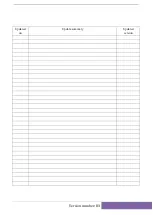
Boost Function
When the speed adaptation has been activated, the system pressure is con‐
tinuously monitored. Thus loads that are switched on are automatically detec‐
ted. If the pressure value falls below a defined threshold (F3.24), the drive
speed is accelerated to the maximum speed defined in F3.20, regardless of
the input from the speed adaptation. The speed adaptation is continued as
soon as the command pressure has been reached again. The following pa‐
rameters have to be configured:
Code
Name
Setting Range
Default
Attri.
F3.23
Speed boost: Ramp pitch
0...30,000 rpm/s
4,000
Run
F3.24
Speed boost: Pressure window
0.0...1,000.0 bar
10.0
Run
F3.25
Speed boost: Wait time
0...10,000 ms
0
Run
Tab. 7-5:
Parameter list of boost function
F3.23 Speed boost: Ramp pitch
In the boost mode, the drive speed is accelerated to the maximum speed de‐
fined in F3.20. This parameter is used to limit the acceleration and avoid dis‐
turbance on the hydro-mechanical pressure controller of the DR/DRG pump.
As the boost function only takes effect when a pressure drop occurs and per‐
sist only for a short time, until pressure has recovered, distinctly steeper
ramps are possible than with ordinary active speed adaptation (cf. F3.21).
F3.24 Speed boost: Pressure window
The boost function is started as soon as the difference between pressure
command value and actual pressure feedback exceeds this threshold value.
The boost function remains active until the pressure command value has
been reached again.
F3.25 Speed boost: Wait time
A small pressure window in F3.24 can lead to a cyclic start of the boost func‐
tion in case of a low damped DR/DRG pressure control loop (e.g. large oil
volume). This parameter defines a minimum time between subsequent boost
sequences to avoid the cyclic start.
The figure below visualizes the parameterization of the boost function.
Bosch Rexroth AG
DOK-SYTROX-DRN5020****-IT05-EN-P
76/143
Frequency-Controlled Pump Drive System Sytronix DRn 5020
Commissioning of Sytronix DRn 5020 System
















































